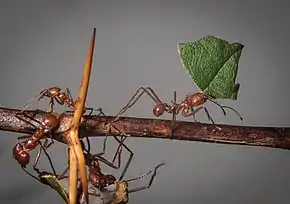Attini
Anergatidini, Basicerotini, Blepharidattini, Cephalotini, Dacetini, Lenomyrmecini, Ochetomyrmecini, Phalacromyrmecini, Pheidolini

| Règne | Animalia |
|---|---|
| Embranchement | Arthropoda |
| Classe | Insecta |
| Ordre | Hymenoptera |
| Famille | Formicidae |
| Sous-famille | Myrmicinae |
- Anergatidini Emery, 1922
- Basicerotini Brown, 1949
- Blepharidattini Wheeler & Wheeler, 1991
- Cephalotini M. R. Smith, 1949
- Dacetini Forel, 1892
- Lenomyrmecini Bolton, 2003
- Ochetomyrmecini Emery, 1914
- Phalacromyrmecini Dlussky & Fedoseeva, 1988
- Pheidolini Emery, 1877
Les Attini sont une tribu de fourmis (Formicidae) de la sous-famille des Myrmicinae.
Présentation
Des espèces fossiles ont été trouvées dans les genres Acanthognathus, Apterostigma, Cephalotes, Cyphomyrmex, Pheidole, Strumigenys et Trachymyrmex.
Les fourmis des genres Atta et Acromyrmex sont des fourmis coupe-feuille qui cultivent des champignons qui produisent des gongylidia, des renflements riches en nutriments dont les fourmis se nourrissent[1].
Synonymes
Cette tribu a de nombreux synonymes.
- Anergatidini Emery, 1922
- Basicerotini Brown, 1949
- Blepharidattini Wheeler & Wheeler, 1991
- Cephalotini M. R. Smith, 1949
- Dacetini Forel, 1892
- Lenomyrmecini Bolton, 2003
- Ochetomyrmecini Emery, 1914
- Phalacromyrmecini Dlussky & Fedoseeva, 1988
- Pheidolini Emery, 1877
Genres
Acanthognathus - Acromyrmex - Allomerus - Apterostigma - Atta - Basiceros - Blepharidatta - Cephalotes - Chimaeridris - Colobostruma - Cyatta - Cyphomyrmex - Daceton - Diaphoromyrma - Epitritus - Epopostruma - Eurhopalothrix - Ishakidris - Kalathomyrmex - Kyidris - Lachnomyrmex - Lenomyrmex - Mesostruma - Microdaceton - Mycetagroicus - Mycetarotes - Mycetophylax - Mycetosoritis - Mycocepurus - Myrmicocrypta - Ochetomyrmex - Octostruma - Orectognathus - Paramycetophylax - Phalacromyrmex - Pheidole - Pilotrochus - Procryptocerus - Protalaridris - Pseudoatta - Rhopalothrix - Sericomyrmex - Strumigenys - Talaridris - Trachymyrmex - Tranopelta - Wasmannia - †Attaichnus
Bibliographie
![]() : document utilisé comme source pour la rédaction de cet article.
: document utilisé comme source pour la rédaction de cet article.
- (en) Mehdiabadi, N.J.; Schultz, T.R. 2010: Natural history and phylogeny of the fungus-farming ants (Hymenoptera: Formicidae: Myrmicinae: Attini). Myrmecological news, 13: 37–55.
- (en) Ward, P.S., Brady, S.G., Fisher, B.L. & Schultz, T.R. 2014 [2015]. The evolution of myrmicine ants: phylogeny and biogeography of a hyperdiverse ant clade (Hymenoptera: Formicidae). Systematic entomology 40(1): 61–81. DOI:10.1111/syen.12090.
- (de) Forel 1892: Attini und Cryptocerini. Zwei neue Apterostigma-Arten. Mitteilungen der Schweizerischen Entomologischen Gesellschaft, 8: 344–349.
- (en) Klingenberg, C.; Brandão, C.R.F. 2009: Revision of the fungus-growing ant genera Mycetophylax Emery and Paramycetophylax Kusnezov rev. stat., and description of Kalathomyrmex n. gen. (Formicidae: Myrmicinae: Attini). Zootaxa, 2052: 1–31.
Liens externes
- Ressources relatives au vivant :
- (en) Australian Faunal Directory
- (en) BugGuide
- (en) Paleobiology Database
- (mul + en) iNaturalist
- (en) Système d'information taxonomique intégré
Notes et références
Notes
Références taxonimiques
- (en) Référence BioLib : Attini
- (fr+en) Référence ITIS : Attini
- (en) Référence NCBI : Attini (taxons inclus)
- (en) Référence Tree of Life Web Project : Attini
- (en) Référence Paleobiology Database : Attini
Références
- (en) Henrik H. De Fine Licht, Jacobus J. Boomsma et Anders Tunlid, « Symbiotic adaptations in the fungal cultivar of leaf-cutting ants », Nature Communications, vol. 5, (ISSN 2041-1723, DOI 10.1038/ncomms6675, lire en ligne, consulté le )
- Portail de l’entomologie